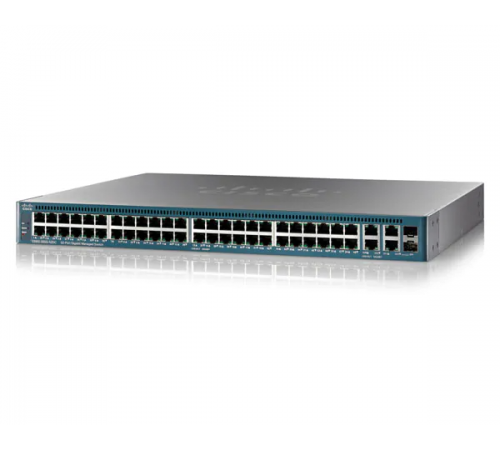
Коммутатор Cisco ;ESW2-550X-48-K9 b - розширений керований комутатор серії Cisco ESW2. Живлення -48 У постійного струму, пропонує високопродуктивні інтерфейси 10 Gigabit Ethernet та оптимізацію енергоефективності.
Комутатори серії Cisco® ESW2 – це нова лінійка комутаторів, оптимізована для позасмугового керування (OOB) центром обробки даних. Комутатори пропонують можливості для розгортання повітряного потоку в гарячому / холодному коридорі в центрі обробки даних, варіанти з живленням від 48 В постійного або змінного струму, резервні вентилятори, можливість нарощування комутаторів для підвищення відмовостійкості, високопродуктивні інтерфейси 10 Gig ). Варіанти повітряного потоку є гнучкими і можуть бути змінені в польових умовах, щоб бути налаштованими як спереду, так і ззаду вперед. Знімні вентилятори підтримують гарячу заміну, що збільшує час безвідмовної роботи мережі.
Комутатори ESW2 забезпечують міцну основу для поточних бізнес-додатків. Вони надають розширені можливості, необхідні для підтримки більш вимогливого мережного середовища за доступною ціною. У той же час ці комутатори прості у розгортанні та управлінні без великого ІТ-персоналу.
Комутатори Cisco серії ESW2 забезпечують:
- Знімні вентилятори з можливістю гарячої заміни для збільшення часу безвідмовної роботи мережі
- Просте встановлення та керування - інтуїтивно зрозумілі інструменти на основі браузера спрощують установку та налаштування
- Повний інтерфейс командного рядка (CLI)
- Душевний спокій - всі комутатори Cisco серії ESW2 захищені протягом усього терміну служби обмеженою довічною гарантією на обладнання Cisco.
Cisco серії ESW2:
ESW2-350G-52
Feature | Description | |||||||||||||||||||||||||||||
Performance | ||||||||||||||||||||||||||||||
Product Name | Switching Capacity (Gbps) | |||||||||||||||||||||||||||||
ESW2-350G-52 | 77.38 | 104 | ||||||||||||||||||||||||||||
ESW2-350G-52DC | 77.38 | 104 | ||||||||||||||||||||||||||||
ESW2-550X-48 | 130.95 | 176 | ||||||||||||||||||||||||||||
ESW2-550X-48DC | 130.95 | 176 | ||||||||||||||||||||||||||||
Layer 2 Switching | ||||||||||||||||||||||||||||||
Spanning Tree Protocol | 16 instances are supported. | |||||||||||||||||||||||||||||
Port grouping/link aggregation | VLAN | Voice VLAN | Multicast TV VLAN | Q-in-Q | VLANs transparently cross over a service provider network while isolating traffic among customers. | |||||||||||||||||||||||||
GVRP/GARP | ||||||||||||||||||||||||||||||
DHCP Relay at Layer 2 | Works with DHCP Option 82. | |||||||||||||||||||||||||||||
IGMP (versions 1, 2, and 3) snooping | ||||||||||||||||||||||||||||||
IGMP querier | HOL blocking | Jumbo Frames | Layer 3 | |||||||||||||||||||||||||||
IPv4 routing | CIDR | RIP v2 (on 550X) | VRRP (on 550X) | DHCP Relay at Layer 3 | Stacking | |||||||||||||||||||||||||
Hardware stack | High availability | |||||||||||||||||||||||||||||
Hot swap of units in stack Flexible stacking port options | ||||||||||||||||||||||||||||||
High-speed stack interconnects | Mixed stacking support | Security | ||||||||||||||||||||||||||||
SSH | SSL | IEEE 802.1X | STP BPDU Guard | This avoids accidental topology loops. | ||||||||||||||||||||||||||
STP Root Guard | DHCP snooping | This prevents IP Address Spoofing. | ||||||||||||||||||||||||||||
Dynamic ARP Inspection (DAI) | не є статичним або динамічним IP/MAC bindings або якщо вони є розрізнення між джерелом або адресою адреси в ARP packet. This prevents man-in-the-middle attacks. | |||||||||||||||||||||||||||||
Secure Core Technology (SCT) | Secure Sensitive Data (SSD) | Port security | RADIUS/TACACS+ | Supports RADIUS and TACACS authentication. Switch functions as a client. | ||||||||||||||||||||||||||
RADIUS accounting | data to be sent at the start and end services, indicating the amount of sources (sub as time, packets, bytes, and so on) useed during the session. | |||||||||||||||||||||||||||||
Storm control | DoS prevention | DoS attack prevention. | ||||||||||||||||||||||||||||
Congestion avoidance | . | |||||||||||||||||||||||||||||
Levels 1, 7, and 15 privilege levels. | ||||||||||||||||||||||||||||||
ACLs | Time-based ACLs supported. / | |||||||||||||||||||||||||||||
Quality of Service | ||||||||||||||||||||||||||||||
Priority levels | Scheduling | Class of service | Port based; 802.1p VLAN priority based; IPv4/v6 IP precedence/ToS/DSCP based; DiffServ; classification and re-marking ACLs, Trusted QoS Rate limiting | Ingress policer; egress shaping and ingress rate control; per VLAN, per port, and flow based | ||||||||||||||||||||||||||
Standards | ||||||||||||||||||||||||||||||
Standards | IEEE 802.3 10BASE-T Ethernet, IEEE 802.3u 100BASE-TX Fast Ethernet, IEEE 802.3ab 10BASE-T Ethernet, IEEE 802.3ab Gigabit Ethernet, IEEE 802.3ad Link Aggregation Control Protocol, IEEE 802.3z Gigabit Ethernet, IEEE 802.3x Flow Control, IEEE 802.3 ad LACP, IEEE 802.1D (STP, GARP та GVRP), IEEE 8 STP, IEEE 802.1s Multiple STP, IEEE 802.1X Port Access Authentication, IEEE 802.3af, IEEE 802.3at, RFC 768, RFC 783, RFC 791, RFC 792, RFC 88, 88 , RFC 854, RFC 855, RFC&856, RFC 858, RFC 894, RFC 919, RFC 922, RFC 920; RFC 1157, RFC 1350, RFC 1533, RFC 133, RFC 3C, RFC 2C, RFC 3C, RFC ;3413, RFC 3414, RFC 3415, RFC 2576, RFC 4330, RFC 1213, RFC 1215, RFC 1286, RFC 1442, RFC 1451, RFC 1493, RFC 1573, RFC 1643, RFC 1757, RFC 2C6, RF6, 6 RFC 2819, RFC 2863, RFC 1157, RFC 1493, RFC 1215, RFC 3416 | |||||||||||||||||||||||||||||
IPv6 | ||||||||||||||||||||||||||||||
IPv6 | IPv6 QoS | IPv6 ACL | MLD Snooping | IPv6 applications | TFTP, SNMP, RADIUS, Syslog, DNS client | |||||||||||||||||||||||||
IPv6 RFC supported | Management | |||||||||||||||||||||||||||||
Web user interface | ||||||||||||||||||||||||||||||
SNMP | Standard MIBs | IP-MIB UDP-MIB VRRPV3-MIB | ||||||||||||||||||||||||||||
Private MIBs | RMON | Embedded and events) для покращеного транспортного менеджменту, monitoring, and analysis | ||||||||||||||||||||||||||||
Firmware upgrade | Port mirroring |
| ||||||||||||||||||||||||||||
VLAN mirroring | DHCP (Options 12, 66, 67, 82, 129, and 150) | obtain IP address, auto configuration (with configuration file download), DHCP Relay, і host name. | ||||||||||||||||||||||||||||
Text-editable configs | facilitating easier mass deployment. | |||||||||||||||||||||||||||||
Smartports | Auto Smartports | Automatically applies intelligence delivered through the Smartports roles to port based on devices overed Cisco Discovery Protocol or LLDP-MED. | ||||||||||||||||||||||||||||
Secure Copy (SCP) | Textview CLI | Cloud Services | Support for Cisco OnPlus. | |||||||||||||||||||||||||||
Localization | Login banner | Time-based port operation | Link up or down based on user-defined schedule administratively up). | |||||||||||||||||||||||||||
Other management | Traceroute; single IP management; HTTP/HTTPS; SSH; RADIUS; port mirroring; TFTP upgrade; DHCP клієнт; BOOTP; Simple Network Time Protocol (SNTP); Xmodem upgrade; cable diagnostics; Ping; syslog; Telnet client (SSH secure support); Automatic time settings from Management Station. | |||||||||||||||||||||||||||||
Green (Power Efficiency) | ||||||||||||||||||||||||||||||
Energy Detect | Cable length detection | Adjusts the signal strength based on the cable length. Reduces the power consumption for cable shorter than 10 m. | ||||||||||||||||||||||||||||
EEE compliant (802.3az) | Supports IEEE 802.3az on all Gigabit copper ports. | |||||||||||||||||||||||||||||
Disable port LEDs | General | |||||||||||||||||||||||||||||
Jumbo frames | MAC table | 16,000 MAC addresses. | ||||||||||||||||||||||||||||
Discovery | ||||||||||||||||||||||||||||||
Bonjour | ||||||||||||||||||||||||||||||
Cisco Discovery Protocol | Product Specifications | |||||||||||||||||||||||||||||
Power Consumption | Model Name | Green Power (mode) | Heat Dissipation (BTU/hr) | |||||||||||||||||||||||||||
ESW2-350G-52 | 110V=40.7W | 137 | ||||||||||||||||||||||||||||
ESW2-350G-52DC | 48V=40.32W | 137 | ||||||||||||||||||||||||||||
ESW2-550X-48 | 110V=56.8W | 189.5 | ||||||||||||||||||||||||||||
ESW2-550X-48DC | 235.7 | |||||||||||||||||||||||||||||
Ports | Model Name | Total System Ports | RJ-45 Ports | Combo Ports (RJ-45 + SFP) | ||||||||||||||||||||||||||
ESW2-350G-52 | 52GE | 52 GE | 2 GE SFP combo ports | |||||||||||||||||||||||||||
ESW2-350G-52DC | 52GE | 52 GE | 2 GE SFP combo ports | |||||||||||||||||||||||||||
ESW2-550X-48 | 48GE + 4 10GE | 48 GE | ESW2-550X-48DC | 48GE + 4 10GE | 48 GE | Buttons | Reset button | |||||||||||||||||||||||
Cabling type | LEDs | System, fan, primary (550X), stack ID (550X), Link/Act, speed. Flash | 800 MHz ARM CPU memory | |||||||||||||||||||||||||||
Packet buffer | All numbers aggregate across all ports, as the buffers are dynamically shared: | |||||||||||||||||||||||||||||
Model Name | Packet Buffer | |||||||||||||||||||||||||||||
ESW2-350G-52 | 2*8 Mb | |||||||||||||||||||||||||||||
ESW2-350G-52DC | 2*8 Mb | |||||||||||||||||||||||||||||
ESW2-550X-48 | 2*12 Mb | |||||||||||||||||||||||||||||
ESW2-550X-48DC | 2*12 Mb | |||||||||||||||||||||||||||||
Supported SFP/SFP+ Modules | SKU | Media | Speed | Typical Distance | ||||||||||||||||||||||||||
MFEFX1 | Multi-mode fiber | 100 Mbps | 2 km | |||||||||||||||||||||||||||
MFELX1 | Single-mode fiber | 100 Mbps | 10 km | |||||||||||||||||||||||||||
MFEBX1 | Single-mode fiber | 100 Mbps | 20 km | |||||||||||||||||||||||||||
MGBBX1 | Single-mode fiber | 1000 Mbps | 40 km | |||||||||||||||||||||||||||
MGBSX1 | Multi-mode fiber | 1000 Mbps | 300 m | |||||||||||||||||||||||||||
MGBLH1 | Single-mode fiber | 1000 Mbps | 40 km | |||||||||||||||||||||||||||
MGBLX1 | Single-mode fiber | 1000 Mbps | 10 km | |||||||||||||||||||||||||||
MGBT1 | UPT cat 5 | 1000 Mbps | 100 m | |||||||||||||||||||||||||||
SFP-H10GB-CU1M | Copper coax | 10G (SG550X) | 1 m | |||||||||||||||||||||||||||
SFP-H10GB-CU3M | Copper coax | 10G (SG550X) | 3 m | |||||||||||||||||||||||||||
SFP-H10GB-CU5M | Copper coax | 10G (SG550X) | 5 m | |||||||||||||||||||||||||||
SFP-10G-SR | Multi-mode fiber | 10 Gig | 300 m | |||||||||||||||||||||||||||
SFP-10G-LR | Single-mode fiber | 10 Gig | 10 km | |||||||||||||||||||||||||||
SFP-10G-LRM | Single-mode fiber | 10 Gig | 40 km | |||||||||||||||||||||||||||
Stack Connection Options | ||||||||||||||||||||||||||||||
| 550X / 500X | |||||||||||||||||||||||||||||
550X | Environmental | |||||||||||||||||||||||||||||
Model Name | Unit Dimensions | |||||||||||||||||||||||||||||
ESW2-350G-52 | 440 x 44 x 357 mm | |||||||||||||||||||||||||||||
ESW2-350G-52DC | 440 x 44 x 357 mm | |||||||||||||||||||||||||||||
ESW2-550X-48 | 440 x 44 x 357 mm | |||||||||||||||||||||||||||||
ESW2-550X-48DC | 440 x 44 x 357 mm | |||||||||||||||||||||||||||||
Unit weight | Model Name | Unit Weight | ||||||||||||||||||||||||||||
ESW2-350G-52 | 5.07 kg | |||||||||||||||||||||||||||||
ESW2-350G-52DC | 5.02 kg | |||||||||||||||||||||||||||||
ESW2-550X-48 | 5.15 kg | |||||||||||||||||||||||||||||
ESW2-550X-48DC | 5.10 kg | |||||||||||||||||||||||||||||
Power | 100-240V 47-63 Hz, internal, universal – AC versions Certification | Operating temperature | 32° to 122°F (0° to 50°C) | |||||||||||||||||||||||||||
Storage temperature | –4° to 158°F(–20° to 70°C) | |||||||||||||||||||||||||||||
Operating humidity | 10% to 90%, relative, noncondensing | |||||||||||||||||||||||||||||
Storage humidity | 10% to 90%, relative, noncondensing | |||||||||||||||||||||||||||||
Model Name | Fan (Number) | Acoustic Noise | MTBF @ 25°C (Hours) | MTBF @ 50°C (Hours) | ||||||||||||||||||||||||||
ESW2-350G-52 | 2 pcs/5000rpm | 383429 | 136378 | |||||||||||||||||||||||||||
ESW2-350G-52DC | 2 pcs/5000rpm | Front-to-Back: 39dB 477673 | 151294 | |||||||||||||||||||||||||||
ESW2-550X-48 | 2 pcs/5000rpm | 333458 | 118456 | |||||||||||||||||||||||||||
ESW2-550X-48DC | 2 pcs/5000rpm | 372522 | 123004 | |||||||||||||||||||||||||||
Reversible fans; Default front to rear airflow | ||||||||||||||||||||||||||||||
Warranty | ||||||||||||||||||||||||||||||
Немає запитань про цей товар.



